|
Help
|
|
Browse
|
Search
|
There is a page named "Cladrastis kentukea" on this wiki
- Cladrastis kentukea I, the copyright holder of this work, hereby publish it under the following licenses: This file is licensed under the Creative Commons...(480 × 640 (41 KB)) - 18:00, 18 March 2024
- 0 Creative Commons Attribution-Share Alike 4.0 truetrue English Cladrastis kentukea author name string: Krzysztof Ziarnek, Kenraiz Wikimedia username:...(4,000 × 6,000 (9.51 MB)) - 18:00, 18 March 2024
- 0 Creative Commons Attribution-Share Alike 4.0 truetrue English Cladrastis kentukea author name string: Krzysztof Ziarnek, Kenraiz Wikimedia username:...(4,830 × 3,220 (2.04 MB)) - 18:00, 18 March 2024
- DescriptionCladrastis kentukea Strączyn żółty 2021-10-02 01.jpg Polski: Strączyn żółty (Cladrastis kentukea), okaz uprawiany w Ogrodzie Botanicznym Uniwersytetu...(3,802 × 2,852 (3.13 MB)) - 18:00, 18 March 2024
- DescriptionCladrastis kentukea Strączyn żółty 2017-10-15 01.jpg Polski: Strączyn żółty (Cladrastis kentukea, syn. Cladrastis lutea) w jesiennej szacie...(4,608 × 3,456 (3.43 MB)) - 18:00, 18 March 2024
- DescriptionCladrastis kentukea Strączyn żółty 2017-10-15 03.jpg Polski: Strączyn żółty (Cladrastis kentukea, syn. Cladrastis lutea) w jesiennej szacie...(3,456 × 4,608 (3.17 MB)) - 18:00, 18 March 2024
- DescriptionCladrastis kentukea Strączyn żółty 2017-10-15 04.jpg Polski: Strączyn żółty (Cladrastis kentukea, syn. Cladrastis lutea) w jesiennej szacie...(4,608 × 3,456 (3.54 MB)) - 18:00, 18 March 2024
- DescriptionCladrastis kentukea Strączyn żółty 2017-10-15 02.jpg Polski: Strączyn żółty (Cladrastis kentukea, syn. Cladrastis lutea) w jesiennej szacie...(4,608 × 3,456 (3.46 MB)) - 18:00, 18 March 2024
- DescriptionCladrastis kentukea 8zz.jpg English: Location taken: The Botanical Gardens at Asheville, Asheville N.C.. Names: Cladrastis kentukea (Dum.Cours...(2,336 × 3,504 (4.73 MB)) - 18:00, 18 March 2024
- DescriptionCladrastis kentukea 12zz.jpg English: Location taken: North Carolina Arboretum, Asheville, NC. Names: Cladrastis kentukea (Dum.Cours.)Rudd...(1,728 × 1,152 (1.63 MB)) - 18:00, 18 March 2024
- truetrue English Close-up of the flowers of Pink-flowered Yellowwood - Cladrastis kentukea 'Perkin's Pink' author name string: Francis Groeters Wikimedia username:...(2,448 × 3,264 (2.97 MB)) - 18:00, 18 March 2024
- DescriptionCladrastis kentukea 13zz.jpg English: Location taken: North Carolina Arboretum, Asheville, NC. Names: Cladrastis kentukea (Dum.Cours.)Rudd...(1,152 × 1,728 (1.72 MB)) - 18:00, 18 March 2024
- Attribution-Share Alike 4.0 truetrue English Pink-flowered Yellowwood - Cladrastis kentukea 'Perkin's Pink' author name string: Francis Groeters Wikimedia username:...(2,448 × 3,264 (3.84 MB)) - 18:00, 18 March 2024
- DescriptionCladrastis kentukea 11zz.jpg English: Location taken: North Carolina Arboretum, Asheville, NC. Names: Cladrastis kentukea (Dum.Cours.)Rudd...(1,728 × 1,152 (1,003 KB)) - 18:00, 18 March 2024
- DescriptionCladrastis kentukea 9zz.jpg English: Location taken: The Botanical Gardens at Asheville, Asheville N.C.. Names: Cladrastis kentukea (Dum.Cours...(3,504 × 2,336 (6.32 MB)) - 18:00, 18 March 2024
- DescriptionCladrastis kentukea 6zz.jpg English: Location taken: The United States National Arboretum, Washington DC. Names: Cladrastis kentukea (Dum.Cours...(1,000 × 667 (199 KB)) - 18:00, 18 March 2024
- DescriptionCladrastis kentukea 7zz.jpg English: Location taken: The United States National Arboretum, Washington DC. Names: Cladrastis kentukea (Dum.Cours...(1,000 × 667 (159 KB)) - 18:00, 18 March 2024
- DescriptionCladrastis kentukea 10zz.jpg English: Location taken: North Carolina Arboretum, Asheville, NC. Names: Cladrastis kentukea (Dum.Cours.)Rudd...(1,152 × 1,728 (1.4 MB)) - 18:00, 18 March 2024
- DescriptionCladrastis kentukea Yellowwood Leaf 3008px.jpg A photograph of a leaf of the Yellowwood Tree (Cladrastis kentukea en ). Photo taken at the...(3,008 × 2,000 (2.69 MB)) - 18:00, 18 March 2024
- DescriptionWeener - Hessepark - Hessepark + Cladrastis kentukea 04 ies.jpg Deutsch: Cladrastis kentukea im Hessepark in Weener Date 18 October 2017, 13:38:14 (according...(5,616 × 3,744 (27.17 MB)) - 15:31, 9 September 2020
Celtis is a genus of about 60–70 species of deciduous trees, commonly known as hackberries or nettle trees, widespread in warm temperate regions of the Northern Hemisphere. The genus is part of the extended Cannabis family (Cannabaceae).
Description
Celtis species are generally medium-sized trees, reaching 10–25 metres (33–82 feet) tall, rarely up to 40 m (130 ft) tall. The leaves are alternate, simple, 3–15 centimetres (1+1⁄4–6 inches) long, ovate-acuminate, and evenly serrated margins. Diagnostically, Celtis can be very similar to trees in the Rosaceae and other rose motif families.[citation needed]
Small flowers of this monoecious plant appear in early spring while the leaves are still developing. Male flowers are longer and fuzzy. Female flowers are greenish and more rounded.[citation needed]
The fruit is a small drupe 6–10 millimetres (1⁄4–3⁄8 in) in diameter, edible in many species, with a dryish but sweet, sugary consistency, reminiscent of a date.[citation needed]
Taxonomy
Previously included either in the elm family (Ulmaceae) or a separate family, Celtidaceae, the APG III system places Celtis in an expanded hemp family (Cannabaceae).[1][2]
Phylogeny
Members of the genus are present in the fossil record as early as the Miocene of Europe, and Paleocene of North America and eastern Asia.[3][4]
Species
66 species are currently accepted.[5]


- Celtis adolfi-friderici Engl. (western and central Africa)
- Celtis africana Burm.f. – white stinkwood (Afromontane region)
- Celtis australis L. – European hackberry, European nettle tree, or lote tree (Mediterranean Basin)
- Celtis balansae Planch. (New Caledonia, Australia)
- Celtis berteroana Urb. (Cuba, Hispaniola, Jamaica)
- Celtis bifida J.-F. Leroy (Madagascar)
- Celtis biondii Pamp.
- Celtis boninensis Koidz. (Japan – southwestern Honshu, western Kyushu, Ryukyu Islands, Ogasawara Islands)
- Celtis brasiliensis Planch.
- Celtis bungeana L. – Bunge's hackberry
- Celtis caucasica L. – Caucasian hackberry
- Celtis caudata Planch. (Mexico and Central America)
- Celtis cerasifera C.K.Schneid. (central and southern China, southeastern Tibet, and northern Myanmar)
- Celtis chekiangensis C.C.Cheng (China – Anhui and Zhejiang)
- Celtis chichape (Wedd.) Miq. (Bolivia, Paraguay, Uruguay, northern Argentina, and southern Brazil)
- Celtis conferta Planch. – cottonwood
- Celtis conferta subsp. conferta – New Caledonia
- Celtis conferta subsp. amblyphylla – Lord Howe Island
- Celtis ehrenbergiana (Klotzsch) Liebm. – spiny hackberry, granjeno (Spanish) (southern US, Mexico, Greater Antilles, northern South America)
- Celtis eriocarpa Decne.
- Celtis glabrata Steven ex Planch. (syn. Celtis planchoniana K.I.Chr.) (eastern Europe and western Asia)
- Celtis gomphophylla Baker (central and eastern Africa, Madagascar, Mayotte)
- Celtis harperi Horne ex Baker
- Celtis hildebrandii Soepadmo
- Celtis hypoleuca Planch. (New Caledonia, Australia)
- Celtis iguanaea (Jacq.) Sarg. – iguana hackberry (Florida (US), Mexico, Caribbean, Central and South America)
- Celtis jamaicensis Planch.
- Celtis jessoensis Koidz. – Japanese hackberry (Japan & Korea)
- Celtis julianae C.K.Schneid. – Julian hackberry China
- Celtis koraiensis L. – Korean hackberry
- Celtis labilis L. – Hubei hackberry
- Celtis laevigata Willd. – southern or sugar hackberry (southern US, Texas), sugarberry (eastern USA, northeastern Mexico)
- Celtis latifolia (Blume) Planch.
- Celtis lindheimeri Engelm. ex K.Koch – Lindheimer's hackberry (Texas (US), Coahuila (Mexico))
- Celtis loxensis C.C.Berg
- Celtis luzonica Warb. (Philippines)
- Celtis madagascariensis Sattarian (Madagascar)
- Celtis mauritiana Planch. (syn. Celtis prantlii Priemer ex Engl.) (tropical Africa and western Indian Ocean)
- Celtis mildbraedii Engl. (tropical Africa and Madagascar)
- Celtis neglecta Zi L.Chen & X.F.Jin
- Celtis occidentalis L. – common or northern hackberry, false elm (eastern North America)
- Celtis orthocanthos Planch.
- Celtis pacifica Planch.
- Celtis pallida Torr. – desert or shiny hackberry (southwestern US / Texas, northern Mexico)
- Celtis paniculata (Endl.) Planch. – whitewood (eastern Malesia, eastern Australia, Micronesia, western Polynesia)
- Celtis petenensis Lundell
- Celtis philippensis Planch.
- Celtis punctata (Urb. & Ekman) Urb. & Ekman
- Celtis reticulata Torr. – netleaf hackberry (western North America)
- Celtis rigescens (Miq.) Planch.
- Celtis rubrovenia Elmer
- Celtis salomonensis Rech.
- Celtis schippii Standl.
- Celtis serratissima Zamengo, R.B.Torres, Gaglioti & Romaniuc
- Celtis sinensis Pers. – Chinese or Japanese hackberry, Chinese nettle tree (China and Japan)
- Celtis solenostigma Unwin
- Celtis spinosa Spreng.
- Celtis strychnoides Planch.
- Celtis tala Gillet ex Planch. – tala (South America)
- Celtis tenuifolia Nutt. – dwarf hackberry (North America)
- Celtis tessmannii Rendle. (central Africa)
- Celtis tetrandra Roxb. – Nilgiri elm
- Celtis tikalana Lundell
- Celtis timorensis Span. – kayu busok
- Celtis toka (Forssk.) Hepper & J. R. I. Wood (western, north-central, and northeastern Africa)
- Celtis tournefortii L. – Oriental hackberry
- Celtis trinervia Lam. – almex[6]
- Celtis vandervoetiana C.K.Schneid.
- Celtis vitiensis A.C.Sm.
- Celtis zenkeri Engl. (western, central, and eastern Africa)
Removed from genus
- Trema cannabina Lour. (as C. amboinensis Willd.)
- Trema lamarckiana (Schult.) Blume (as C. lamarckiana Schult.)
- Trema orientalis (L.) Blume (as C. guineensis Schumach. or C. orientalis L.)
- Trema tomentosa (Roxb.) H.Hara (as C. aspera Brongn. or C. tomentosa Roxb.)[7]
Etymology
The generic name originated in Latin and was applied by Pliny the Elder to the unrelated Ziziphus lotus.[8]
Distribution and habitat
The trees are widespread in warm temperate regions of the Northern Hemisphere, including Southern Europe, South and East Asia, southern and central North America,[9] south and central Africa, and northern and central South America.
Ecology
Some species, including common hackberry (C. occidentalis) and C. brasiliensis, are honey plants and a pollen source for honeybees of lesser importance.
Lepidoptera
Celtis species are used as food plants by the caterpillars of certain Lepidoptera. These include mainly brush-footed butterflies, most importantly the distinct genus Libythea (beak butterflies) and some Apaturinae (emperor butterflies):

- Acytolepis puspa – common hedge blue, recorded on Chinese hackberry (C. sinensis)
- Automeris io – Io moth, recorded on southern hackberry (C. laevigata)
- Asterocampa celtis – hackberry butterfly or hackberry emperor
- Libythea celtis – European beak
- Libythea labdaca – African beak
- Libythea lepita – common beak
- Libythea myrrha – club beak, recorded on C. tetrandra[10][11]
- Libytheana carinenta – American snout or common snout butterfly
- Nymphalis xanthomelas – scarce tortoiseshell, recorded on European hackberry (C. australis)
- Sasakia charonda – great purple emperor, recorded on C. jessoensis and C. sinensis
- A putative new taxon of the two-barred flasher (Astraptes fulgerator) cryptic species complex, provisionally called "CELT," has hitherto only been found on C. iguanaea.[12][13]
Pathogens
The plant pathogenic basidiomycete fungus Perenniporia celtis was first described from a Celtis host plant. Some species of Celtis are threatened by habitat destruction.
Uses
Several species are grown as ornamental trees, valued for their drought tolerance. They are a regular feature of arboreta and botanical gardens, particularly in North America. Chinese hackberry (C. sinensis) is suited for bonsai culture; a magnificent specimen in Daegu-myeon is one of the natural monuments of South Korea.
The berries are generally edible when they ripen and fall.[14] C. occidentalis fruit was used by the Omaha, eaten casually, as well as the Dakota people, who pounded them fine, seeds and all. The Pawnee used the pounded fruits in combination with fat and parched corn.[15] The berries of C. douglasii are also edible, and were consumed by the Mescalero Apaches.[16]
Hackberry wood is sometimes used in cabinetry and woodworking.[citation needed]
Gallery
-
C. aetnensis with mature fruit
-
Caucasian hackberry (C. caucasica) with immature fruit
-
African hackberry (C. integrifolia)
-
Chinese hackberry (C. sinensis)
-
C. australis autumn leaves
References
- ^ Stevens, P.F., Angiosperm Phylogeny Website: Cannabaceae
- ^ "Celtis". Germplasm Resources Information Network. Agricultural Research Service, United States Department of Agriculture. Retrieved February 12, 2012.
- ^ MacPhail, M. K., N. F. Alley, E. M. Truswell and I. R. K. Sluiter (1994). "Early Tertiary vegetation: evidence from spores and pollen." History of the Australian Vegetation: Cretaceous to Recent. Ed. Robert S. Hill. Cambridge University Press. pp. 189–261. ISBN 0521401976.Partially available on Google Books.
- ^ Manchester, S. R., Akhmetiev, M. A., & Kodrul, T. M. (2002). Leaves and fruits of Celtis aspera (Newberry) comb. nov. (Celtidaceae) from the Paleocene of North America and eastern Asia. International Journal of Plant Sciences, 163(5), 725-736.
- ^ Celtis L. Plants of the World Online, Kew Science. Accessed 11 December 2022.
- ^ MacVean, A.L. 2021. Celtis trinervia. The IUCN Red List of Threatened Species 2021: e.T179045950A149309679. https://dx.doi.org/10.2305/IUCN.UK.2021-1.RLTS.T179045950A149309679.en. Downloaded on 28 April 2021.
- ^ "GRIN Species Records of Celtis". Germplasm Resources Information Network. United States Department of Agriculture. Archived from the original on 2009-01-20. Retrieved 2010-12-04.
- ^ Quattrocchi, Umberto (2000). CRC World Dictionary of Plant Names. Vol. I A–C. CRC Press. p. 468. ISBN 978-0-8493-2675-2.
- ^ Keeler, Harriet L. (1900). Our Native Trees and How to Identify Them. New York: Charles Scribner's Sons. ISBN 0873388380. pp. 249–252.
- ^ Ravikanthachari, Nitin (April 2018). "Larval host plants of the butterflies of the Western Ghats, India". Research Gate.
- ^ Wahlberg, Niklas (October 2006). "Libythea myrrha Godart 1819". Tree of Life Web Project.
- ^ Brower, Andrew V.Z. (2006). Problems with DNA barcodes for species delimitation: ‘ten species’ of Astraptes fulgerator reassessed (Lepidoptera: Hesperiidae). Systematics and Biodiversity 4(2): 127–132. doi:10.1017/S147720000500191X PDF fulltext
- ^ Hebert, P. D. N.; Penton, E. H.; Burns, J. M.; Janzen, D. H.; Hallwachs, W. (2004). "Ten species in one: DNA barcoding reveals cryptic species in the neotropical skipper butterfly Astraptes fulgerator". Proceedings of the National Academy of Sciences. 101 (41): 14812–14817. Bibcode:2004PNAS..10114812H. doi:10.1073/pnas.0406166101. PMC 522015. PMID 15465915. PDF fulltext Supporting Appendices
- ^ The Complete Guide to Edible Wild Plants. United States Department of the Army. New York: Skyhorse Publishing. 2009. p. 58. ISBN 978-1-60239-692-0. OCLC 277203364.
{{cite book}}: CS1 maint: others (link) - ^ "Uses of plants by the Indians of the Missouri River region". Washington, Govt. print. off. 1919.
- ^ Peattie, Donald Culross (1953). A Natural History of Western Trees. New York: Bonanza Books. p. 472.
External links
 Media related to Celtis at Wikimedia Commons
Media related to Celtis at Wikimedia Commons- . Encyclopædia Britannica. Vol. 19 (11th ed.). 1911. p. 422.



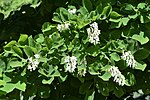





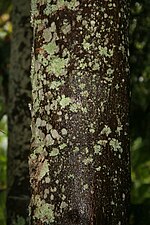


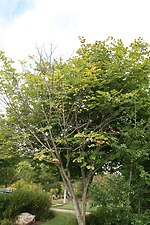
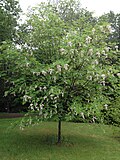

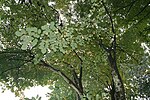
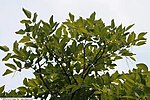
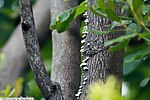
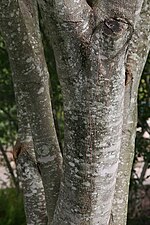

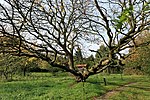






Recent Comments